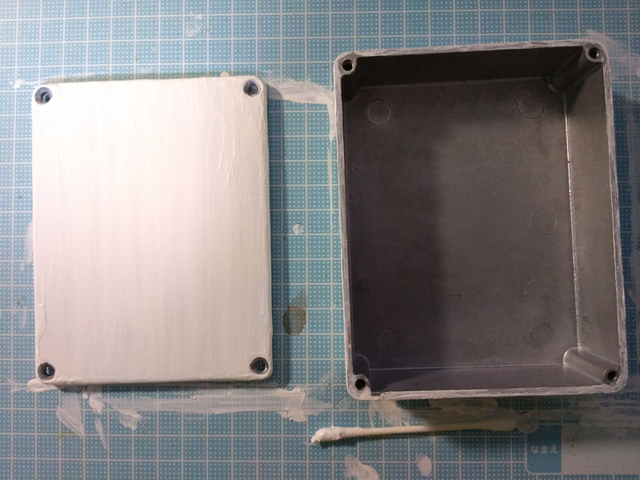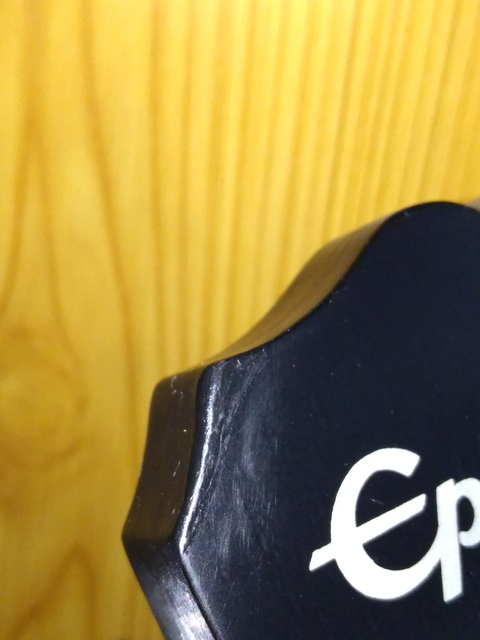HR Noise 8: Makunouchi Placing
Last Updated on July 13, 2020
First Published on July 4, 2020
So, attaching a ferrite core to the cable between Les Paul SL and my DIY preamp seems to reduce high frequency noise. Things on ferrite cores will come out in the next time. In this article, I'm coating an aluminum box for the enclosure of my DIY preamp. The box is same sized as Hammond 1590BB aluminum box. I searched Hammond's one because generics have slightly different dimension. However, it was difficult to purchase the one on out of stock and I got one of generics. 1590BB has popular dimension for DIY guitar pedals. Actually, it can be the "Makunouchi" placing for parts, but not "Noriben" placing like on 1590B. I used waterborne acrylics, black and white, for interior and exterior coating. Acrylic coating is weaker than other methods, however waterborne acrylic is less smelled and overpainting strengthen the coating. The ingredients of the paint is PMMA, pigment, and water. Probably the paint have more PMMA than acrylic color for the art. I bought these paints and a brush at a 100 yen (110 yen = 1 dollar these days) shop. Note that a new brush needs to remove fallen bristles in advance, and arrange the tip if you watch any unevenness.
* "Makunouchi" placing is the styling of take-out meal (also called bento at the west coast). It is named because of a gorgeous meal in a large box which people eat at special seats in theaters and stadium such as Kabuki Theater and Sumou Arena. Note that "Ma
* "Noriben" placing is also the styling of take-out. It's typically placed a fried fish, an egg roll, and pickled radish on rice. The rice is also covered by nori, seaweed. I think it's the symbol of the post-booming era in 90's, temperance and financial anxiety. I considered to describe several scenes of the era in this section, however it's omitted because of boring. BUT, I'd like to notice that there were young people such as "painters with no canvas" in Kabukicho at Shinjyuku, Tokyo. They would be tired because of broken anti-consumption-tax protest. LA suffered the earth quake at the same time. Over the ocean 11 hours away by plane, they actually smoked in Tokyo. It was also the time when the new car of domestic T brand became apparently strange for pricing down. PCB may be fit with the style, but the DIY universal board may not be fit with the style because of annoyed wiring.
* So, "anti-consumption-tax protest" is the significant scene in last days of the booming. They attached loud speakers on wagons and repeatedly shouted out "No Consumption Tax!" (「消費税反対!」) near train stations. I counter-protested to them, "Shut Up" (「うるさい!」). It's the zero point as the origin of battling against them. The tax started in 1989 with their hopelessness. I would understand to sell ice candies, but they just sold loud noise by wagon.
I spend 5 days for coating. Before coating, I washed the box with dish soap to remove remained machine oil and dried. Because this box is made of aluminum casting, the surface has already had roughness not to peel off the coat. Get hand gloves not to get coated hands. Caution that the paint makes stain on your cloth, even in wet sanding after drying the paint.
Day 1: Painting and drying three times. Be cautious about small bubbles and dusts in painting. To hide small bubbles, trace the texture the brush made. Overpaint after dried out, otherwise lumps are made. Get 3-4 hours interval in 26 degrees Celsius cloudy (at the summer rainy season). If you're in the factory, it may be made by dipping or so. Masking in holes, but it's the mistake.
* The paint tends to remain brushstrokes on the surface. If you want no brushing texture, using a sponge brush may be good.
Day 2: Sanding sponge #180 to remove masking tapes and papers. Tape glue is sticked and the coating on the edges is peeled! Get overall coating one time and repairing edges by cotton swabs. Small bubbles made craters.
* Sticked tape glue seems to be caused by the wetty condition of masking tapes in sanding.
Day 2 (2): A little painting again.
Day 3: #180 sanding sponge and the peeled off edges of the lid. Repair and overall again. Hmmm, #180 seemed to be coarse. Anyway, let's another color.
Day 3 (2): Another color. Going to overpaint once.
Day 3 (3): Black overpainting until no white color at all.
Day 4: Black overpainting again and drying.
Day 5: Sanding by #600 and #1000 waterproof papers. Like second-hand.
On the last, I rubbed the surface by Vaseline as the substitution of wax. Acrylic coating tends to absorb moisture, so the coat may stick with paper and other surfaces. Wax gives the coat moisture in advance. If you want to paint signs, don't wax before painting.
So, my guitar hit a shelf and the neck edge slightly cracked. Sanding #1000 waterproof then overpainting several times using cotton swabs. I used tissue papers for sanding after painting because of the weakness of the coat. Polished by Vaseline.
Let's "Makunouchi" placing! It's easy to plot. I also learned LibreCad, an open source 2D CAD, on Linux Raspbian 10 Buster. It's so precise to place electric parts and plot drilling holes through drawing parallel and center lines in draft. As long as using lathes, 3D modeling can be produced by 2D CAD by indicading the radius of every curve. So, LibreCad can draw Bezier curves (also referred to as Bezier splines) through the "splines" function. However, you need to draw the approximation of a Bezier curve by circles and indicate radius of each curves if you want precision of the mechanical work by lathe. Bezier curves are used to draw streamliners.
* Recent lathes are computers. If you say Bezier curves can be through programming codes, you may be intoxicated by the big data world where telephone companies are advertising. As long as programming codes, you need to review these. Every program with short codes are better than long one which possibly have more errors. Bezier curves have a lot of numerical data, whereas Radius is just one number. Things in milling machines are the same as lathes' ones.
In the terminal, command these to install the software;
sudo apt-get update
sudo apt-get install librecad
In my experience, Windows version of LibreCad (2.1.3) seems to be freezed on drawing lines in the construction layer.
Schematic: Download PDF File: Preamp combined with Impedance Transformer







